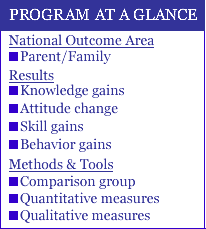
2001
Exemplary
Program
Evaluations
Exemplary
Program
Evaluations

| State: | Montana | ||||
| Project name: | Educating Families to Achieve Independence (EDUFAIM) | ||||
| Participants: | Low income adults | ||||
| Number involved: |
Over 4 years more than 1,000 have participated in two communities (encompasses 7 geographic counties including 1 Native American reservation) |
||||
| 172 matched pre- and posttests | |||||
| Program: | Education is provided in the following areas: | ||||
| nutrition | |||||
| parenting | |||||
| money management | |||||
| job readiness skills | |||||
| housing improvements | |||||
| Where: | Programs delivered in a variety of places | ||||
| When: | Series of 6 to 10 classes depending on the topic area | ||||
| Who: | Extension agents and paraprofessional staff provide the educational programs | ||||
| To increase the knowledge, skills, behaviors and health orientation that promote self-sufficient living in a cost effective manner | |||||
| Client empowerment for obtaining employment | |||||
| Mental health/well-being | |||||
| Knowledge and behaviors in specific area classes taught | |||||
| Client perceptions of growth (transformative learning) | |||||
| Impact of programming on cost associated with welfare programming | |||||
| Methods & Tools | |||||||||||||
| Objectives 1&2: | EDUFAIM survey given to clients as they entered the program and again 3 months later—client demographics, personal variables, measure on empowerment to seek employment (Objective 1) and constructs associated with mental health (Objective 2). | ||||||||||||
| 11 measures to evaluate motivational, cognitive, locus of control and self-efficacy aspects of individual empowerment (Objective 1) | |||||||||||||
| 5 psychometric measures which included self-esteem, global life satisfaction, positive and negative affect, anxiety, and depression (Objective 2) | |||||||||||||
| Objective 3: | Surveys were developed by the program originators for each class so relevant outcomes could be assessed for each of the following classes: being a parent, self and relationship, job readiness, money management, eating right, housing, getting hired. | ||||||||||||
| Surveys were given prior to and after completing the class | |||||||||||||
| Objective 4: | Interviews were conducted on a sample of EDUFAIM clients to understand the clients' perceptions of the EDUFAIM program and the impact it had on them. | ||||||||||||
| Open-ended questions designed to gather information related to transformational learning as a result of EDUFAIM programming | |||||||||||||
| Identify aspects of programming that were significant from the client's perspective | |||||||||||||
| In-depth interviews with 74 randomly selected EDUFAIM clients | |||||||||||||
| Objective 5: | Analysis of state welfare data supplied by the Montana Department of Public Health and Human Services and the impact of EDUFAIM affiliation on cost related measures. | ||||||||||||
| Analysis | |||||||||||||
| Objective 1: | Used SPSS to conduct t-tests to compare pre- and 3 month follow-up data | ||||||||||||
| Objective 2: | Used SPSS to conduct t-tests to compare pre- and 3 month follow up data | ||||||||||||
| Objective 3: | Used SPSS to compute percentages for pretest and posttest | ||||||||||||
| Objective 4: | Used NUD*IST for qualitative analysis of all interview data—7 themes identified | ||||||||||||
| Objective 5: | Logistic regression was employed to determine the impact of EDUFAIM affiliation on cost related measures | ||||||||||||
| Results | |||||||||||||
| Statistically significant improvement in the following areas were found at some point over the 4-year evaluation results: job seeking efficacy and perceived job seeking efforts. | |||||||||||||
| Global measure of life satisfaction, positive and negative affect, anxiety, and depression measures all showed a statistically significant improvement. | |||||||||||||
| In 85% of the areas measured, more clients responded correctly in the posttest than in the pretest Although this was not noted in all classes, the overall trend indicated positive changes in reported behaviors, knowledge, and attitudes across the vast majority of classes evaluated. | |||||||||||||
| Seven themes were identified that crosscut the interview questions. The themes were labeled life skills, empowerment, social benefits, program value, facilitating learning, program weakness, and "just do it." Based on inductive analyses of client responses, it was concluded that EDUFAIM was fostering transformative learning. Narratives from clients demonstrated an empowered sense of self, fundamental changes in self-perception, adoption of more functional approaches to life, and growth in other ways. | |||||||||||||
| EDUFAIM clients had almost two times the probability of obtaining any employment and more than two times the probability of generating any earnings. | |||||||||||||
| To assess program effectiveness | ||||
| Program planning | ||||
| Program modification | ||||
| Documentation in grant proposal writing | ||||
| Reports to collaborators and funders | ||||
| Marketing to potential funders | ||||
| Marketing to the community | ||||
| For support to replicate program in other places | ||||
| Tim
Dunnagan Email: uhdtd@montana.edu |
||||
| EDUFAIM survey | ||||
| Pre- and posttests for each topical program | ||||
| Interview questions related to transformational learning | ||||